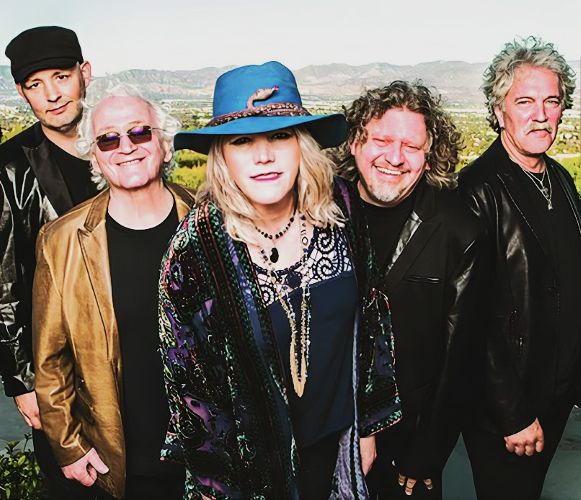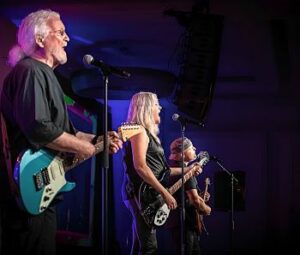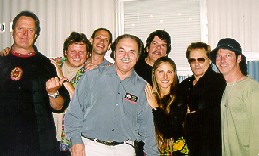How to Hire JEFFERSON STARSHIP For Your Event!
From Psychedelic Roots to Arena Rock Legends
Members:
David Freiberg, Donny Baldwin, Chris Smith, Cathy Richardson, Jude Gold
Based in the U.S.
Hire Jefferson Starship
Jefferson Starship emerged from the legendary psychedelic rock band Jefferson Airplane, which was a key player in the San Francisco music scene of the 1960s. After Jefferson Airplane disbanded in 1972, guitarist and vocalist Paul Kantner formed a new group, initially as a side project, and named it Jefferson Starship. The name was inspired by his 1970 solo album Blows Against the Empire, which featured contributions from various Airplane members and other musicians.
Early Years and Formation (1973–1974)
Kantner officially launched Jefferson Starship in 1973, bringing in former Jefferson Airplane bandmates Grace Slick (vocals) and David Freiberg (bass, keyboards, vocals). Other early members included Craig Chaquico (lead guitar), John Barbata (drums), and Papa John Creach (violin). The band’s debut album, Dragon Fly (1974), was well received and marked the beginning of their transition into a more commercial rock sound.
Hire Jefferson Starship for your festival or concert plans! (t,s)
Breakthrough Success with “Red Octopus” (1975–1977)
In 1975, Jefferson Starship released Red Octopus, which became their biggest success. The album reached #1 on the Billboard 200 and featured the hit single “Miracles”, a love ballad written by Marty Balin, who had rejoined the band. The song became their most recognizable hit of the decade and solidified the band’s commercial appeal.
The following albums, Spitfire (1976) and Earth (1978), continued their success, producing hits like “With Your Love” and “Count on Me”. However, tensions within the band began to grow, leading to personnel changes.
Major Lineup Changes and Evolution (1978–1984)
- 1978: Marty Balin left the band, and Grace Slick departed shortly after due to personal struggles.
- 1979: Freedom at Point Zero introduced a harder rock sound, featuring new lead vocalist Mickey Thomas and the hit “Jane”, which became a rock radio staple.
- 1981: Modern Times included the single “Find Your Way Back”, further defining their arena rock style.
- 1982: Grace Slick rejoined the band for Winds of Change.
- 1984: Nuclear Furniture continued their success but also marked the beginning of Kantner’s growing dissatisfaction with the band’s increasing commercialization.
Legal Disputes and Transition to Starship (1984–1985)
Paul Kantner left the band in 1984 and took legal action to prevent the remaining members from using the “Jefferson” name. The band, now consisting of Mickey Thomas, Grace Slick, and Craig Chaquico, shortened its name to Starship in 1985. Under this new identity, the band released Knee Deep in the Hoopla (1985), featuring the massive hits “We Built This City” and “Sara”, both of which became pop anthems of the 1980s.
Revival of Jefferson Starship (1992–Present)
In the early 1990s, Paul Kantner reclaimed the Jefferson Starship name and reformed the band with David Freiberg, Jack Casady, and other musicians. This version of Jefferson Starship focused on classic rock-oriented performances, blending Jefferson Airplane and Jefferson Starship hits.
The band continued to tour and record new material, releasing albums such as Windows of Heaven (1999) and Jefferson’s Tree of Liberty (2008). After Kantner’s passing in 2016, David Freiberg continued to lead the band, ensuring the legacy of Jefferson Starship remained alive.
Legacy and Influence
Jefferson Starship remains one of the most significant rock bands to emerge from the psychedelic era, evolving through multiple incarnations to maintain its presence in rock history. From psychedelic rock to arena rock and pop, the band navigated numerous transformations while leaving a lasting impact on American music
Jefferson Starship, a collaboration of celebrated musicians that plays from the rich songbook of its legendary forefathers Jefferson Airplane and the original incarnation of Jefferson Starship, prevails as one of the most critically acclaimed touring acts today. Steeped in the fantastic realms of science fiction and the contemporary American shadow land, Jefferson Starship features a stellar cast of old and new players, including vocalist Marty Balin and bassist Jack Casady, all of whom were crucial in developing the renowned “San Francisco Sound” that changed the course of pop music forever.
In 1965, Paul Kantner and Balin formed Jefferson Airplane, embarking from Balin’s San Francisco nightclub The Matrix. With Casady, guitarist Jorma Kaukonen, vocalist Signe Anderson and drummer Skip Spence, Jefferson Airplane became the first San Francisco rock group to sign a recording contract with a major label. Their first album on RCA, “Jefferson Airplane Takes Off,” was released in 1966. Vocalist Grace Slick joined the Airplane in 1967, bringing with her the hits “Somebody to Love” and “White Rabbit,” anthems that announced the Summer of Love and permanently altered the perspective of an entire generation. Both songs hit the Top 10 that year, making Jefferson Airplane the most successful rock band in America.
Richard De La Font
with Jefferson Starship
Born of the decade marked by civil rights activism, the war in Vietnam and the counterculture Mecca of San Francisco’s Haight-Ashbury, Kantner’s group defined the psychedelic nation with their appearances at the Monterey Pop, Woodstock and Altamont music festivals. Now icons in the reformation of American music and thought, the LPs “Surrealistic Pillow,” “Crown of Creation,” “Bless Its Pointed Little Head” and “Volunteers” surpassed the limits of musical and lyrical expression previously unexplored, introducing strident and striking political tracts, yet capable of evoking the most tender emotions.
Jefferson Airplane broke up in 1972, leaving in its wake the canon of work that includes “It’s No Secret,” “My Best Friend,” “Comin’ Back To Me,” “Plastic Fantastic Lover,” “We Can Be Together,” “Today,” “Wooden Ships” (with David Crosby and Stephen Stills) and “Volunteers” (which, nearly 30 years after its inception, was featured in the Oscar-winning film Forrest Gump and the PBS documentary Baseball).
Earlier, in 1970, Kantner embodied his utopian vision of music and community with the science fiction opus “Blows Against the Empire.” Recorded with Slick, Jerry Garcia, Mickey Hart, Bill Kreutzmann, David Crosby, Graham Nash and David Freiberg, “Blows Against the Empire” was nominated for science fiction literature’s prestigious Hugo Award. To date, the album is the only recording in rock ‘n’ roll history to have been honored so.
The “Blows Against the Empire” collaboration was the prototype for Kantner’s next ensemble, Jefferson Starship, which he formed in 1974. Joined by Balin, Slick, lead guitarist Craig Chaquico, bassist Pete Sears and drummer John Barbata, the first incarnation of Jefferson Starship reigned as one of the most artistically and commercially successful rock groups for a decade.
The band’s initial release, “Dragonfly,” spawned the rock radio staples “Ride the Tiger” and “Caroline,” both penned by Kantner. The band’s breakthrough album came a year later with “Red Octopus,” which featured the hit single, “Miracles”, and catapulted the group to the top of Billboard’s album chart four separate times in 1975. The band’s subsequent releases – “Spitfire” (1976), “Earth” (1978), “Freedom at Point Zero” (1979), “Winds of Change” (1981), and “Nuclear Furniture” (1983) – generated the hits “With Your Love,” “St. Charles,” “Count on Me,” “Runaway” and “Jane.”
Balin left the group in 1979 to pursue a solo career. His 1980 debut release, “Balin,” yielded the hit “Hearts.” In 1983, Kantner released his second solo album, “Planet Earth Rock & Roll Orchestra,” featuring guitarist Ronnie Montrose, Slick and China Kantner, the daughter of Kantner and Slick. The next year, Kantner departed from Jefferson Starship to work on his own projects.
Kantner rejoined with Balin and Casady in 1985 to form the KBC BAND which featured keyboardist Tim Gorman from The Who and guitarist Slick Aguilar from David Crosby’s band. In 1987, Kantner embarked on a fact-finding tour of Nicaragua and the Sandinista government. Upon his return to the U.S., he published his journals of the trip in “Paul Kantner’s Nicaragua Diary.”
In 1989, Kantner briefly reunited with Jefferson Airplane, a much-anticipated project that resulted in an album, “Jefferson Airplane,” and a summer tour. Two years later, Kantner was back on the road with a stripped-down, acoustic ensemble called Paul Kantner’s Wooden Ships, a trio that included Aguilar and Gorman from the KBC BAND. In addition to his classic songs, Kantner and his group performed new material which received resounding praise. The success of this project prompted Kantner to reinvent his electric band and Jefferson Starship took off once again. In addition to Aguilar and Gorman, Kantner recruited former collaborators Casady and the late blues violin master, Papa John Creach, former Tubes drummer Prairie Prince, and former World Entertainment War vocalist Darby Gould. Shortly after the band’s rebirth, Marty Balin rejoined Jefferson Starship, ending a 15-year hiatus from the group.
Papa John died in early 1993, weeks after touring Europe. Concurrently, a sensational young vocalist, Diana Mangano joined the group with her debut at “Woodstock In Mexico,” replacing Gould, and in 1996, 6-time Grammy nominated keyboardist T Lavitz (Dixie Dregs, Widespread Panic) replaced Gorman. In classic Kantner style, the group expands at times to include family members Slick and China, original Jefferson Airplane vocalist Signe Anderson, drummers Trey Sabatelli and Dean Johnson, & keyboardist John Ferensic (from Todd Rundgren Band).
In 1995, Jefferson Starship headlined a tribute to the at Hollywood’s House of Blues, broadcast nationally on the CBS Radio Network Concert Series. With very special guest, Grace Slick (in her last live performance to date), they debuted new material, together with timeless classics, comprising the 1995 release, “Deep Space/Virgin Sky.”
In 1996 Kantner, Balin & Casady were inducted into The Rock & Roll Hall of Fame as part of Jefferson Airplane. Since reforming, Jefferson Starship has performed more than 500 concerts in 16 countries.
#1. How do I book Jefferson Starship? See below.
Hire Jefferson Starship for your party or event!
Learn booking fee and availability.
#2. How much does it cost to book Jefferson Starship? See below.
Jefferson Starship may be available for your next special event!
#3. What is the Jefferson Starship booking fee? See below.
Book Jefferson Starship, now!
For other great suggestions regarding booking popular music acts and contact information, look here.
Check Jefferson Starship tour dates:
Watch Jefferson Starship Videos:
Upcoming Tour Dates for Jefferson Starship on Ticketmaster
- November 22, 2025 — Jefferson Starship
Westgate Las Vegas Resort & Casino, Las Vegas, Nevada
Buy Tickets - October 16, 2025 — Jefferson Starship
Golden State Theatre, Monterey, California
Buy Tickets - November 21, 2025 — Jefferson Starship
The Guild Theatre - CA, Menlo Park, California
Buy Tickets - December 5, 2025 — Jefferson Starship (21 and Over)
Hard Rock Live Tulsa, Catoosa, Oklahoma
Buy Tickets - October 23, 2025 — Jefferson Starship - 50th Anniversary Tour, Runaway Again Tour
River Cree Resort & Casino, Enoch, Alberta
Buy Tickets
- Hire Jefferson Starship. -







